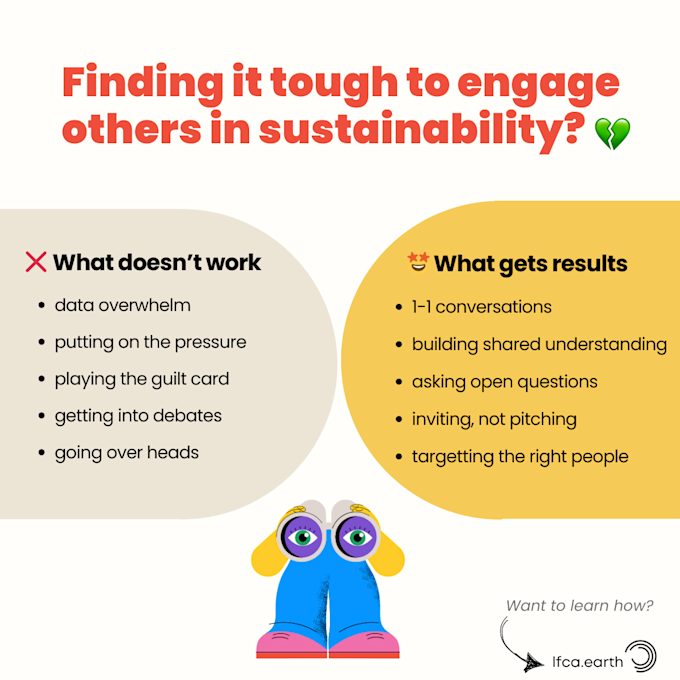So you’ve done the research & developed a proposal for an impactful sustainability initiative. Now for the hard part: convincing the key people to get on board!
Earlier this year, LFCA members were surveyed to reveal that:
56% of our members that we surveyed felt that their team felt threatened by change and were actively resisting it
92% felt too under-resourced to embark on any action
Before we share the things that work, what are the things that we know don't? Research & experience warns against the following common tactics:
Piling on more data (creates overwhelm)
Guilt (can work for the short term, but never builds lasting engagement)
Arguing or debating about climate science (climate deniers love to waste time on a good argument!)
Talking about the scarcity of resources
Attempting to by-pass opponents for more senior people (or, how to lose friends and alienate people)
Instead, getting your team onboard new sustainability initiatives requires a mix of three particular skills: empathy, effective communication and pitching value.
More on this later, but first let’s start with WHO you need to focus on. A simple first step we recommend is to draft a power/influence matrix to identify your key people and make sure you’re not missing anyone.

Who are your allies?
Next, it can be useful to map out each of these people’s positions. The Spectrum of Allies (invented by George Lakey) is a convenient resource to do just that. With it, you can assess who is involved in a project, where they sit, and whether it’s worth engaging with them. It can actually be applied to multiple contexts, whether that be external activism or corporate sustainability. Let’s explore each position on the spectrum.

Over on the left, we have active allies - like you, these are people who are already invested and engaged.
A passive ally fully supports your ideas, but isn't doing anything about it. They’ll say they’re great and love the ideas, but you won't see any action. It’s generally valuable to mobilize these people as it’s an easy win.
Neutral people couldn't care less either way. They are typically not engaged in sustainability and it’s not part of their daily work. They could be convinced either way, but could just as easily be convinced by the active opposition. They’re a good group to actively engage to ensure they stay on the right side.
Passive opposition are people who disagree with you, but aren't doing anything about it. They're not necessarily volatile yet, but could easily be swayed that way and should be kept an eye on.
Active opposition are those who seek to block or shut down any plans that you have, and turn others against them too.
How to use it?
To use this tool, we recommend having a specific goal in mind. Focus on one aspect of your sustainability initiative that you'd like to build a team for, rather than on sustainability as a whole in your organisation.
Draw a half-moon and add the relevant people to each segment for a specific project. Keep in mind that the spectrum is always changing! People can easily change their position depending on the day or topic. You might need to have open conversations to find out where particular people stand, too.
Determine which group(s) you should focus your energy on. You may choose to split your time between groups. For example, if 80% of the people in your organization are in the neutral category, it might be worth it to spend most of your time there. Leveraging them might make a large difference and get more departments involved. You could alternatively decide to divide your time, i.e. focusing on both passive allies who won't be too difficult to convince to do something for the project, and on your active opponents who may occupy important roles in your organization.
Let's remember, like all tools, this one is flawed. Make an effort to avoid things like:
The unconstructive othering or generalisation of a particular group of people
Excluding some people from important conversations as a result
Getting frustrated when someone doesn’t fall into a clear category, or moves around a lot. This is normal! If in doubt, try to make your ‘question’ more specific to the current project.
This tool is useful as a framework but does not need to be precisely adhered to. Approach it mindfully!

A final thought on the topic of who to involve is to consider your ‘organic leaders’.
This idea comes from Jane McAlevey, via the Rosa Luxembourg Foundation. An Organic Leader is someone who people in your organization generally really look up to and who has a lot of influence socially and at work. Crucially, they might not agree with your project or sustainability in general. They may even appear as an active opponent! However, they are worth thinking about because to have them on board would be hugely influential to your project, even if they take a lot of work. Be aware that sometimes organic leaders are leaders for the wrong reasons. Remain skeptical trying to get them on board and be aware of their core beliefs. It is generally preferable to actively leverage someone with good intentions, and rather actively ‘manage’ others.
In Part 2, we’ll focus on how to effectively engage and onboard your key people to contribute to your initiatives. Watch this space!

